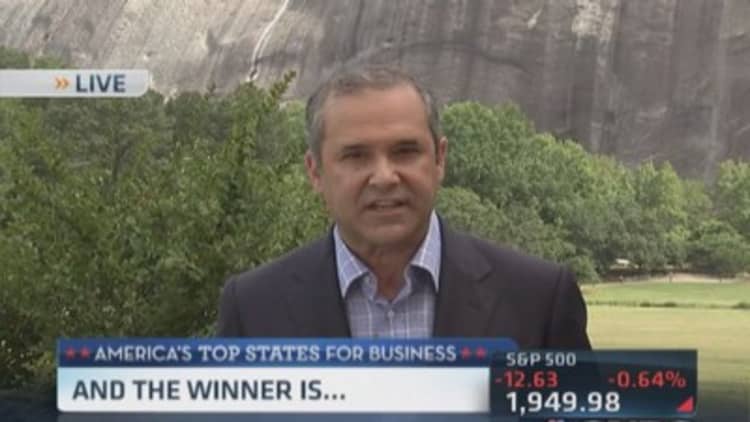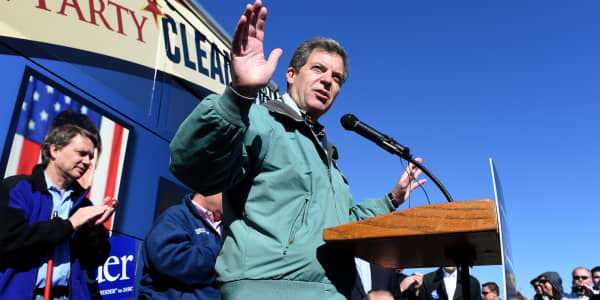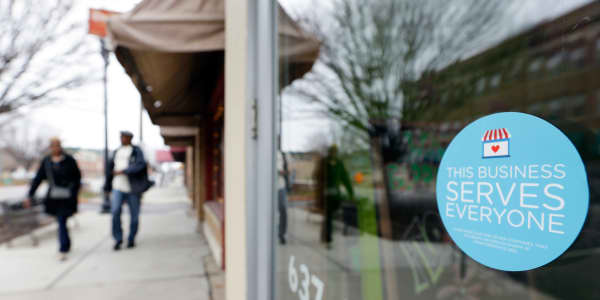Five years into a recovery from the worst economic crisis since the Great Depression, state budget planning remains closer to an austerity mind-set than reflecting what has been an extended bull market.
For five consecutive fiscal years through 2013, state spending has trended up—an encouraging sign—but it's still well below the long-term average growth in annual state spending. The fiscal 2015 proposed spending increase across U.S. states of 2.9 percent is just a little more than half the historical average of 5.5 percent since 1979, according to the National Association of State Budget Officers (NASBO).
Read MoreA 2014 scorecard on how America's states stack up
Debt issuance by states, meanwhile, has declined in recent years, even as the economy has expended and during an unprecedented low-interest-rate environment. State governments and state agencies issued less debt than in the prior year in 4 out of the past 5 years. In 2013, states issued 26.5 percent less debt than they had four years earlier, according to Bond Buyer data. The trend has persisted into 2014 as well, with total debt issuance through the first quarter coming in 23.9 percent below that of the first quarter of 2013.
"There is an austerity mind-set even six years after the crash," said Brian Sigritz, director of state fiscal studies for the NASBO, which released its latest fiscal survey of the states in mid-June. "I think they are more hopeful and things have improved, but states have not returned to the level where they were before the crash. Things are still too tight," Sigritz said.
"States are still not recovered fully from the recession," said Lucy Dayadan, senior policy analyst at the Nelson A. Rockeller Institute of Government. "Spending is still not where it's supposed to be or where it should be compared to 2008."
The nature of the economic recovery is part of the issue. "It was a really severe recession and slower-than-average recovery," said Robin Prunty, managing director of public finance ratings at Standard & Poor's. "We're cautiously optimistic the recovery will continue and states will focus on structural alignment and growing reserves, which has been the typical pattern during recovery periods. ... It's just that it hasn't been as easy. ... To see five years into a recovery continued austerity focus is unusual," Prunty said.
Read MoreEconomy shrank more than expected in Q1
In the back of state budget managers' minds six years after the financial crisis is a data point recently highlighted in an S&P report: The eight recessions that have occurred since 1961 happen, on average, once every 6.6 years. It's an alarming statistic, but public finance experts expect U.S. GDP growth to continue on par with the sluggish nature of the economy in recent years—in fact, some experts contend that the slower-than-normal economic rebound makes them more confident that the 6.6-year average between recessions will not apply to the current business cycle.
Read MoreStates get nasty in fight for jobs
"Going back to 2000, in the last 15 years there have been two major business cycles that had a significant impact on state and local finances," said Moody's managing director Bob Kurtter. "But we're in a period of much more predictable, steady growth, and unless there are external shocks, we don't expect the current course of the economy to change immediately."
The April surprise
The current slow-and-steady environment means that state revenue, even if recovering, is not uncovering new sources of growth. This is a cash-management challenge, according to Laura Porter, managing director of public finance at Fitch Ratings.
Any hiccup in state revenue forecasting, and the budget picture can change in a hurry. In fact, this is the biggest topic of conversation among municipal finance experts right now, and it's being called "the April surprise."
Recently released revenue figures from states for the month of April—the key month for income-tax revenue guidance, since it is the filing month—showed a big drop in revenue derived from income tax. A decline in state revenue from income tax was expected; the magnitude of the decline was not.
Read MoreThe other high-tech battle between US states: Farming
Many taxpayers took actions to minimize their expected federal tax liability on capital gains and other investment income in the 2013 tax year, with changes to federal tax law that were expected to go into effect in January 2013. This led to a onetime surge in income-tax collections for the 2012 tax year (fiscal year 2013 for the states ). The acceleration in tax collections last year "left states with a dark cloud over revenue projections for fiscal year 2014," The Rockefeller Institute of Government stated in a recent analysis. The dark cloud surfaced in April in income-tax revenue declines that were described by Rockefeller as "large and widespread."
There will have to be cuts in some cases or onetime methods to fill in the gap, tapping rainy-day funds when they should be refilling. It depends state to state. They were really over in projections for income tax in New Jersey. Five percent is significant."Lucy Dayadansenior policy analyst at The Nelson A. Rockeller Institute of Government
"It's definitely impacting 2014 budgets," Sigritz said. "We have seen some states revising revenue projections down." Eight states have made midyear budget cuts, and NASBO expects that number to creep up into the "low double digits," Sigritz said. It's much less alarming than the 41 states that had to make midyear cuts in 2009, but it does mean there is less money to carry forward across all regions in the U.S., and it hits states the hardest where the percentage of revenue from income tax is higher—typically, states with high-income earners, the NASBO official said.
Overall, state personal income-tax collection fell by 7 percent in the January to April period compared with the year-earlier period, based on data from the 38 states that report the data. Thirty-one states experienced declines; 10 states experienced double-digit declines. States collected $7.9 billion less in April 2014 than in April 2013. "Going into the next fiscal year [which begins for most states in July], they will be dealing with reduced revenue, and that will force some spending constraints," said Nick Samuels, vice president and senior credit officer at Moody's.
New Jersey has become the "poster child" for the April surprise, according to public finance experts, because it is among the most aggressive states when it comes to revenue projections and is also one of the states to derive a very large percentage of revenue from income tax. It ranks eighth among U.S. states in revenue impact from personal income tax, according to The Rockefeller Institute. Rockefeller estimated a 5 percent decline in income-tax revenue for New Jersey.
Read More5 ways states are luring small business
"There will have to be cuts in some cases or onetime methods to fill in the gap, tapping rainy-day funds when they should be refilling," Dayadan said. "It depends state to state. They were really over in projections for income tax in New Jersey. Five percent is significant," she said, adding that "small May and June surprises" should also be expected.
"It's clearly a problem for New Jersey," Kurtter said. "For most states, though, it's a problem of manageable proportions. States are slightly off their revenue forecasts, but with the economy recovering there is still enough strength to keep the short-term income tax decline from having a lasting effect on state finances," he said.

Most states are doing a better job than they were last year in terms of closing budget gaps, Dayadan said. Fourteen states are projecting $8.6 billion in budget gaps to be closed in fiscal 2015—similar to last year's level—but in 2012 states closed $68 billion in budget gaps and in 2013 it was $33.3 billion. The April surprise may not have a long-term lingering effect on states, but she said that the margin of error that states can effectively manage is small when it comes to future budgets.
"There is enough concern over collection levels being slightly off that it has tempered enthusiasm about the pace of revenue recovery," Prunty said, adding, "What has happened in 2014 highlights some weakness and that states need to continue vigilance to keep balanced budgets."
The April surprise comes on the heels of a slow recovery and at a time when long-term-spending pressure points for states are expected to increase in scope—in particular, Medicaid and transportation funding needs.
Gambling with the future
Public finance experts said the only major area of state spending that has seen renewed focus is K-12 education—and that's because cutting education spending in the first place was unprecedented, if required, by the depth of the recession. The issue that gets the most attention—pension underfunding—may have bottomed out, with the worst declines finally behind the states, even if pension fund recovery will remain slow and uneven, according to a new S&P report.
Other spending concerns have come to the forefront. "Spending on Medicaid is still growing faster than overall state budgets, and if that pattern holds, more and more state money will go to Medicaid," Sigritz said. "The transportation pot of money is suffering from what states spend on education and Medicaid, and gas taxes haven't been raised in so long, that hurts them," Sigritz added.
Federal transportation funding has to be reauthorized in the fall through the national Highway Trust Fund. The fund's balances are low and expected to get even lower over the summer, and that is leading up to what is anticipated to be a big debate in Congress over reauthorization of the fund, Samuels said. The upshot: States will have to be very cautious on transportation finance in the months ahead, since it is uncertain how they will make up for the shortfall.
Porter said Fitch is already seeing states reallocating revenue to the transport sector, and this could lead to more direct competition for funds from state coffers.
Read MoreWhy are space companies flocking to Colorado?
The transportation funding situation is a microcosm of the broadest issue of all for states: the creation of new, more stable revenue sources at a time of less federal support and volatility in tax revenue.
Dayadan said she is concerned by where much of the effort from states has been focused in terms of finding new sources of revenue: aggressive efforts by states to expand gambling.
Pennsylvania has grown its gambling industry to collect almost as much as Nevada—while also stealing business from New Jersey. "It's a cautionary tale," Dayadan said. Pennsylvania keeps adding more gaming and trumpets its No. 2 position to Nevada in slot revenue and its largest tax take among all states when it comes to gaming revenue. But Dayadan worries that while newer casinos will grow for a few years, once they become existing casinos, history shows that the growth slows. New Jersey and Pennsylvania have both faced declines in gambling revenue this year as even more states turn to the industry as a source of funding.
"The pool of gaming customers is only so big," Dayadan said.
—By CNBC's Eric Rosenbaum





